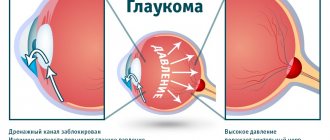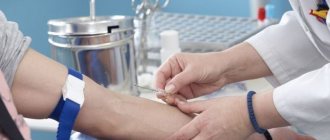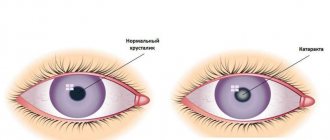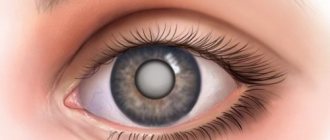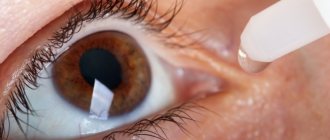The development of cataracts in patients with glaucoma complicates the course of the underlying disease. Cataracts are also one of the many causes of glaucoma in the eye. The co-occurrence of glaucoma and cataracts is one of the most common causes of blindness worldwide.
- What is cataract
- What is glaucoma
- Glaucoma plus cataract. In what cases does one disease become a complication of another?
- The first signs of simultaneous manifestations of glaucoma and cataracts
- Contraindications for glaucoma and cataracts
- Is it possible to have cataract surgery for glaucoma?
- Glaucoma and cataract: simultaneous treatment and surgery
- Combined surgery: lens replacement and anti-glaucoma surgery
- Postoperative and rehabilitation periods
What is glaucoma?
Glaucoma is a group of chronic eye diseases with different etiologies, characterized by a constant or periodic increase in intraocular pressure, under the influence of which the nerve fibers of the retina and optic nerve die, as a result of which typical defects in the visual field are formed, and visual functions are reduced until complete loss of vision.
Combination drugs for glaucoma
Sometimes it is advisable to use combination drugs that consist of components of different pharmacological groups. They are characterized by enhanced action, since both active substances enhance the effect of each other.
Among the combination drugs, the following should be noted:
- Fotil, Timpilo. The drug contains timolol maleate and pilocarpine (two or four percent).
- Xalacom. Contains 2 active components – latanoprost and timolol maleate.
- Azarga. Good drops for eye pressure. The medicine is used for open-angle glaucoma, if monotherapy is not enough. The active ingredients are timolol and brinzolamide.
- Combigan. The composition contains brimonidine and timolol maleate. Both components slow down the production of moisture and help reduce pressure in the eye structures.
Glaucoma plus cataract. In what cases does one disease become a complication of another?
Glaucoma and cataracts occur together so often that doctors talk about cause-and-effect relationships in their development. Most often, glaucoma is complicated by cataracts. Most often, the complication occurs in elderly patients. At a certain stage in the development of glaucoma, one should always expect the addition of cataracts. This occurs due to disturbances in microcirculation inside the eye, which leads to the development of cataracts.
In turn, cataracts in some cases can cause glaucoma. This form of glaucoma is called phacomorphic and develops due to swelling (increase in volume) of the cloudy lens, which in turn causes narrowing and closure of the outflow pathways of intraocular fluid.
Medicines that improve the outflow of intraocular fluid
Source: GlazExpert.ru If, after patients have instilled products containing beta blockers, low effectiveness is noted, then stronger medications are required. Then the doctor prescribes good eye drops for glaucoma, which help to increase the outflow of fluid formed inside the eye. List of effective drugs:
- "Xalatan";
- "Travatan."
The first signs of simultaneous manifestations of glaucoma and cataracts
The primary symptoms of glaucoma and cataracts differ, but when the two diseases combine in the eye, they combine and intensify.
Signs of glaucoma:
- fog before the eye occurs periodically, mainly at night;
- in the initial stages of the disease, visual acuity does not decrease, a gradual narrowing of the visual fields occurs, which a person with glaucoma does not notice;
- rainbow circles around light sources appear periodically;
- there may be pressing, aching pain, a feeling of heaviness in the eyes;
- possible redness of the eye.
Signs of cataracts:
- the appearance of persistent fog in front of the eye, while in sunny weather the fog may intensify;
- vision decreases gradually due to increasing fog;
- the appearance of a persistent halo effect (halo) when looking at a light source;
- there is no pain syndrome;
- the eye does not turn red.
Double acting medications
For severe cataracts and glaucoma, it is recommended to drip products with double action into the eyes. After their use, there is an improvement in fluid outflow and a reduction in its production.
The most commonly used medications are:
- "Brimonidine";
- "Latanoprost";
- "Timolol";
- "Xalacom";
- "Luxfen".
Such drops are best used for open-angle glaucoma, since they do not affect the pupil and do not change the angle of the anterior chamber of the eye.
Is it possible to have cataract surgery for glaucoma?
Cataracts can only be treated surgically. Drug treatment cannot make a clouded lens clear! During the operation, the ophthalmic surgeon removes the clouded lens and implants an artificial intraocular lens in its place.
It is not only possible, but necessary, to perform cataract surgery in the presence of glaucoma. At the same time, earlier surgical intervention makes it possible to more effectively and safely achieve the desired result.
However, eliminating cataracts in glaucoma requires a special approach and careful preparation for surgery.
Eye protection when working at a computer
First of all, it is necessary to ensure the proper organization of the workplace. The distance from the eyes to the monitor is at least 50 cm, and preferably 60 or 70 cm. The room in which a person works should be well lit. Under no circumstances should you sit in the dark looking at a bright monitor.
While working at the computer, you need to take 10-minute breaks every hour.
During rest, it will be useful to perform a set of exercises. This will help relax your eyes and relieve muscle spasms.
To protect your eyes from the bright light of the monitor, you can use computer glasses. A special light filter in them cuts off part of the spectrum, excluding those waves that most irritate and tire the visual organ.
Glaucoma and cataract: simultaneous treatment and surgery
Glaucoma and cataracts require different treatment approaches. Patients with glaucoma reduce intraocular pressure using drops or laser/surgical interventions. It is impossible to get rid of cataracts with medications.
Before proceeding with cataract surgery, it is necessary to achieve compensation (reduction) of intraocular pressure.
To treat glaucoma, one or more antihypertensive medications may be prescribed and used until the day of surgery.
In some cases, surgery for cataracts in a glaucomatous eye can cause a temporary increase in intraocular pressure in the postoperative period, so the hypotensive regimen may intensify.
Pupil dilation
Drugs with this effect can be used for spasms of accommodation.
This type of medication is prescribed for the diagnosis of cataracts and glaucoma. There are also other indications for their use:
- before surgery;
- spasm of accommodation resulting from prolonged visual stress.
List of commonly used drops that dilate the pupil:
- "Irifrin";
- "Mydriacyl";
- "Tropicamide".
Combined surgery: lens replacement and anti-glaucoma surgery
If it is impossible to reduce intraocular pressure to acceptable levels before surgery for cataracts using antihypertensive drops, a decision is made in favor of a combined intervention. It is also possible to carry out 2 operations at different times.
The decision on the tactics of surgical intervention for glaucoma and cataracts is made strictly individually, after conducting a full ophthalmological examination and assessing all possible operational and postoperative risks, as well as taking into account the severity of somatic pathology.
How are eye drops different for these diseases?
The purpose of glaucoma drops is to reduce intraocular pressure to the optimal physiological norm.
Preparations for the treatment of cataracts include components that improve metabolic processes in the visual organs, their blood supply, as well as antioxidants that prevent the formation of free radicals.
Which drops to choose for cataracts?
The following drops occupy the first positions in the ranking of the best drugs for treating the disease.
Taufon
The composition of the therapeutic agent includes the active substance tuarine, which is an amino acid. In ophthalmic practice, this active component is used to improve intraocular metabolic processes, stabilize cell membranes, and restore organ tissue.
Drops help slow down the development of the disease. But treatment with the drug is effective only at the initial stage of the formation of pathological changes.
Among the advantages of the drug is its good tolerance by patients. The product is contraindicated for people with individual intolerance to the components included in its composition.
Taufon is indicated for a long course of treatment. The drug is usually prescribed for 3 months, 2 drops into the conjunctiva up to 4 times a day. It is recommended to take a month's break after this and then carry out therapy again.
The drops are an inexpensive product because they are produced by a domestic manufacturer. Average price – 130 rubles. for 1 bottle.
Oftan Katahrom
Finnish-made cataract drops contain 3 components:
- Adenosine. The action of the energy molecule is aimed at improving metabolic processes in the lens.
- Nicotinamide. Promotes the synthesis of substances that have a positive effect on metabolism.
- Cytochrome C. Is an active participant in redox processes in the body and has antioxidant properties.
Oftan Katahrom drops are intended for the treatment of cataracts at an early stage. They slow down the progression of pathological changes.
Postoperative and rehabilitation periods
Regardless of the scope of surgical intervention in our clinic, operations are performed on an outpatient basis. High-tech techniques and modern equipment used by surgeons at Dr. Kurenkov’s clinic make it possible to avoid performing operations with hospitalization in a hospital.
After surgery, the patient is sent home with a detailed reminder about postoperative restrictions and recommendations for instilling postoperative and antihypertensive drugs.
The next day you need to visit your doctor to assess the condition of the operated eye and correct further treatment. During the rehabilitation process, regular visits to the doctor according to his recommendations are also necessary.
Rules for using eye drops
When instilling a medicinal solution, the following procedure should be followed:
- Warm the bottle of therapeutic agent in your hand.
- Wash your hands well and dry them with a towel.
- Sit comfortably in a chair or lie on the bed and throw your head back a little.
- Place the bottle to your eye at a distance of 2-3 cm.
- Pull your lower eyelid slightly, look up and lightly press the bottle the required number of times so that the drops fall into the conjunctival sac.
- Close your eyes and sit or lie quietly for 1-2 minutes.
- Blot with a clean napkin.
Symptoms
The disease can result in serious vision problems, so the prevention of cataracts is of particular relevance. The disease has several degrees of damage, depending on which various symptoms and manifestations are observed:
- The appearance of a split effect and blurred vision at the moment when one eye is closed.
- Blurry objects, lack of clarity. Wearing glasses and contact lenses does not affect this defect.
- Observing symptoms of myopia.
- Frequent glare, which is mostly typical for the night time.
- Increased sensitivity to bright light.
- Color vision impairment.
